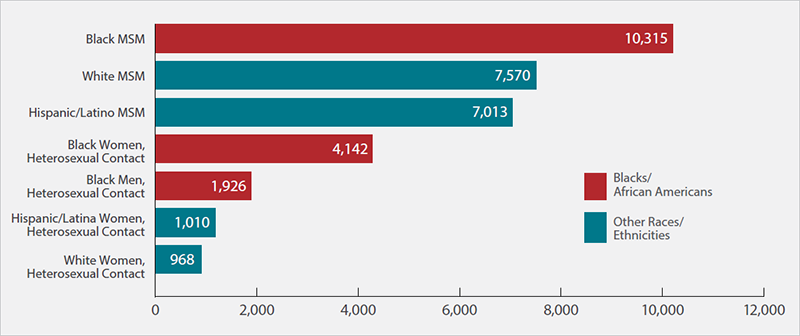HIV Among African Americans
Fast Facts
- African Americans are the racial/ethnic group most affected by HIV in the United States.
- Gay and bisexual men account for a majority of new HIV diagnoses among African Americans.
- There are promising signs of progress, especially among women and those who inject drugs.

Blacks/African Americansa account for a higher proportion of new HIV diagnoses, those living with HIV, and those ever diagnosed with AIDS, compared to other races/ethnicities. In 2015, African Americans accounted for 45% of HIV diagnoses, though they comprise 12% of the US population.b
The Numbers
HIV and AIDS Diagnosesc
In 2015:
- 17,670 African Americans were diagnosed with HIV in the United States (13,070 men and 4,524 women).
- More than half (58%, 10,315) of African Americans diagnosed with HIV were gay or bisexual men.d
- Among African American gay and bisexual men diagnosed with HIV, 38% (3,888) were young men aged 13 to 24.
- 48% (8,702) of those diagnosed with AIDS in the United States were African Americans.
From 2005 to 2014:
- The number of HIV diagnoses among African American women fell 42%, though it is still high compared to women of other races/ethnicities. In 2015, 4,524 African American women were diagnosed with HIV, compared with 1,131 Hispanic/Latino women and 1,431 white women.
- HIV diagnoses among African American gay and bisexual men increased 22%. But diagnoses stabilized in recent years, increasing less than 1% since 2010.
- HIV diagnoses among young African American gay and bisexual men (aged 13 to 24) increased 87%. But that trend has leveled off recently, with diagnoses declining 2% since 2010.
Living With HIV and Deaths
- At the end of 2013, 498,400 African Americans were living with HIV (40% of everyone living with HIV in the US), and 1 in 8 did not know they were infected.
- Of African Americans diagnosed with HIV in 2014, 72% were linked to HIV medical care within 1 month.e
- Of African Americans diagnosed with HIV in 2012 or earlier, 54% were retained in continuous HIV care and 49% had a suppressed viral load (virus at low enough levels to stay healthy and reduce transmission risk).e
- In 2014, 3,591 African Americans died of HIV or AIDS, accounting for 53% of total deaths attributed to the disease that year.
HIV Diagnoses in the United States for the Most-Affected Subpopulations, 2015

Source: Diagnoses of HIV infection in the United States and dependent areas, 2015. HIV Surveillance Report 2016;27. Subpopulations representing 2% or less of HIV diagnoses are not reflected in this chart. Abbreviation: MSM, men who have sex with men.
Prevention Challenges

In all communities, lack of awareness of HIV status contributes to HIV risk. People who do not know they have HIV cannot take advantage of HIV care and treatment and may unknowingly pass HIV to others.
A number of challenges contribute to the higher rates of HIV infection among African Americans. The greater number of people living with HIV (prevalence) in African American communities and the fact that African Americans tend to have sex with partners of the same race/ethnicity mean that African Americans face a greater risk of HIV infection with each new sexual encounter.
Some African American communities continue to experience higher rates of other sexually transmitted diseases (STDs) than other racial/ethnic communities in the United States. Having another STD can significantly increase a person’s chance of getting or transmitting HIV.
The poverty rate is higher among African Americans than other racial/ethnic groups. The socioeconomic issues associated with poverty—including limited access to high-quality health care, housing, and HIV prevention education—directly and indirectly increase the risk for HIV infection and affect the health of people living with and at risk for HIV. These factors may explain why African Americans have worse outcomes on the HIV continuum of care, including lower rates of linkage to care and viral suppression. Stigma, fear, discrimination, and homophobia may also place many African Americans at higher risk for HIV.
What CDC Is Doing
CDC and its partners are pursuing a high-impact prevention approach to advance the goals of the National HIV/AIDS Strategy: Updated to 2020 and maximize the effectiveness of current HIV prevention methods. Some of CDC’s activities include:
- Support for health departments and community-based organizations to deliver effective prevention interventions for African Americans and other populations.
- Comprehensive HIV Prevention Programs for Health Departments, an HIV prevention initiative for health departments in states, territories, and select cities, including those serving African American clients. Starting in 2012, CDC has awarded at least $330 million each year ($343.7 million in 2015) under this funding opportunity.
- Support for health departments to develop comprehensive models of prevention, care, and social services for gay and bisexual men of color living with or at risk for HIV, as well as training and technical assistance to implement and sustain those models.
- A new funding opportunity beginning in 2017 to implement comprehensive HIV prevention programs for young gay and bisexual men of color.
- Two new projects to help health departments reduce HIV infections and improve HIV medical care among gay and bisexual men of color. These funding opportunity announcements (FOAs) will increase gay and bisexual men’s access to pre-exposure prophylaxis (PrEP), increase health departments’ surveillance capacity, and support effective models of prevention and care for gay and bisexual men of color.
- The Act Against AIDS campaigns, including
- Let’s Stop HIV Together, which raises HIV awareness and fights stigma among all Americans and provides many stories about people living with HIV;
-
Doing It, a national HIV testing and prevention campaign that encourages all adults to know their HIV status and protect themselves and their community by making HIV testing a part of their regular health routine;
- Start Talking. Stop HIV. helps gay and bisexual men communicate about safer sex, testing, and other HIV prevention issues.
- HIV Treatment Works, which shows how people living with HIV have overcome barriers to stay in care and provides resources on how to live well with HIV; and
- Partnering and Communicating Together (PACT) to Act Against AIDS, a 5-year partnership with organizations such as the National Black Justice Coalition, the National Urban League, and the Black Men’s Xchange to raise awareness about testing, prevention, and retention in care among populations disproportionately affected by HIV, including African Americans.
a Referred to as African Americans in this fact sheet.
b Does not include African Americans who are Hispanic/Latino.
c HIV and AIDS diagnoses indicate when a person is diagnosed with HIV infection or AIDS, not when the person was infected.
d The term male-to-male sexual contact is used in CDC surveillance systems. It indicates a behavior that transmits HIV infection, not how individuals self-identify in terms of their sexuality. This fact sheet uses the term gay and bisexual men.
e In 32 states and the District of Columbia (the areas with complete lab reporting by December 2015).
Additional Resources
Bibliography
- CDC. Diagnoses of HIV Infection in the United States and Dependent Areas, 2015. HIV Surveillance Report 2016;27. Accessed November 21, 2016.
- Seth P, Walker T, Hollis N, et al. HIV Testing and Service Delivery Among Blacks or African Americans — 61 Health Department Jurisdictions, United States, 2013. MMWR 2015;64:87-90. Accessed November 21, 2016.
- Siddiqi A, Hu X, Hall HI. Mortality Among Blacks or African Americans with HIV Infection — United States, 2008–2012. MMWR 2015;64:81-86. Accessed November 21, 2016.
- CDC. 2013 Sexually Transmitted Diseases Surveillance. Accessed November 21, 2016.
- CDC. Monitoring selected national HIV prevention and care objectives by using HIV surveillance data—United States and 6 dependent areas—2014. HIV Surveillance Supplemental Report 2015;21(4). Accessed November 21, 2016.
- US Census Bureau. Income and Poverty in the United States: 2014. Accessed November 21, 2016.
- US Census Bureau. Health Insurance Coverage in the United States: 2014. Accessed November 21, 2016.
- CDC. High-Impact HIV Prevention: CDC’s Approach to Reducing HIV Infections in the United States. Accessed November 21, 2016.
- CDC. Deaths: final data for 2014. National Vital Statistics Reports 2016; 65(4). Accessed November 21, 2016.
Fact Sheets
Other Resources
Web Sites
General Resources
- CDC-INFO 1-800-CDC-INFO (232-4636)
- CDC HIV Website
- CDC Act Against AIDS Campaign
- CDC HIV Risk Reduction Tool (BETA)
- Page last reviewed: June 9, 2017
- Page last updated: June 9, 2017
- Content source: Division of HIV/AIDS Prevention, National Center for HIV/AIDS, Viral Hepatitis, STD, and TB Prevention, Centers for Disease Control and Prevention


 ShareCompartir
ShareCompartir